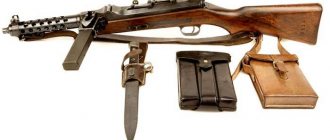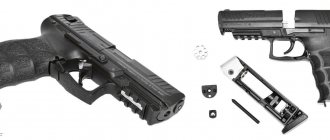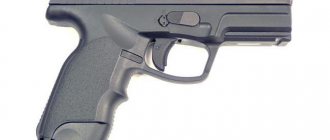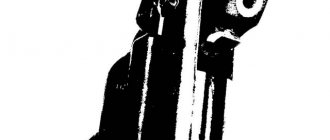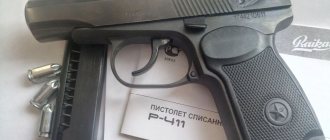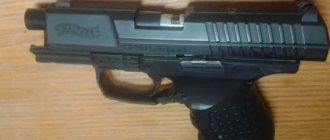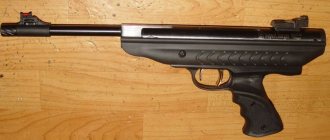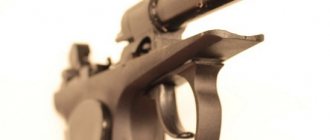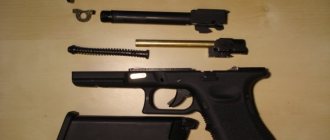Description of the air gun ASG Steyr M9-A1 Dual Tone metal
A gas-cylinder pneumatic pistol that fires 4.5 mm steel shot with a high initial speed of 135 m/s .
This is the speed indicator indicated by the manufacturer in the technical documentation. To confirm or refute the data specified in the technical documentation of the device, Popadiv10.ru store employees fired a shot from a pneumatic ASG Steyr M9-A1 through a chronograph in a video review, the results of which you can see below.
The body of the pistol is made of durable weapons-grade plastic, while the bolt in the pistol is metal, exactly the same as in the Austrian combat pistol Steyr Mannlicher.
The appearance of the pneumatic model, weight, proportions, inscriptions, are practically indistinguishable from the well-known firearm model, there is even the inscription 9x19 on the left side of the bolt.
The high power of the ASG Stair M9-A1 was made possible by minimizing energy consumers and overall tightness. To achieve this, the number of joints and moving parts was significantly reduced. In a pneumatic Stair, the following are movable: a trigger, a button - a magazine ejector, a fuse and a clamping screw.
Since the gun is a gas-cylinder pneumatic gun, the source of energy in it is gas, namely CO2. Replaceable gas cartridges are inserted into the cylinder compartment of the Steyr M9-A1 under the handle pad. You can see how the handle pad moves in the photo. The can is loaded from the left side.
One cylinder is enough for 70-80 shots, after which it is necessary to remove the cylinder. Also, it is not recommended to store the cylinder in the cylinder compartment.
Steel balls are loaded into a row magazine in the amount of 19 pieces. To remove the magazine from the Steyr Mannlicher M9-A1 air pistol with a metal bolt, you must press the oval key located at the junction of the trigger guard and the handle.
The model is equipped with a standard sight for combat and pneumatic models, namely a front sight and rear sight. What’s unusual is that both elements of the open sighting device have fiber-optic threads of orange and light green colors. They contrast with each other and allow targeted fire both in the daytime and during low light conditions, or against the background of dark objects.
An additional sight in this model can be a Laser sight; for installing it on the pistol, there is a guide on the front lower part of the bolt. Various other weapon gadgets can be mounted on this rail. For example, the combination of a tactical flashlight and a standard sight with optical threads works well.
As mentioned earlier, the pneumatic ASG Steyr M9-A1 has a fuse. It is made in the form of a two-position button with an exit to the right side of the case. The safety is located above the trigger. The rear position of the switch corresponds to the combat mode of the pistol, the front position corresponds to the safe mode.
Separately, I would like to note that all ASG products have high performance in terms of accuracy, which has been tested repeatedly by both sellers and buyers.
Pistol Steyr M / Steyr S
| Steyr M40 |
In 1999, the Austrian company Steyr Mannlicher introduced a new Steyr M series pistol, created by a talented designer and passionate fan of bullet shooting, Wilhelm Bubits.
For some time before collaborating with Bubits, he worked at, where he created a pistol of his own design. However, it turned out that the pistol did not meet the requirements of Glock's corporate design and in 1997 Bubits offered his weapon to Steyr. Bubits' partnership with Steyr turned out to be much more successful. Improving his pistol, the designer worked for two years with engineer Friedrich Einer, who also contributed to the creation of this weapon. At the end of 1999, pistols were introduced, designated Steyr M40 and Steyr M9, which used .40 S&W and 9 mm Parabellum cartridges, respectively. On the bolt-casing, next to the letter “M,” the number 40 or 9 is placed, indicating the caliber. Later, in June 2000, a version chambered for .357 SIG appeared.
| Steyr M9 |
The pistols of the Steyr M series differ from each other only in the caliber of ammunition and magazine capacity:
- Steyr M40 – caliber .40 S&W, magazine capacity 12 rounds.
- Steyr M9 – caliber 9 mm Parabellum, magazine capacity of 15 rounds. Also under this designation, at the request of the customer, pistols chambered for 9x21 mm were produced.
- Steyr M357 – .357 SIG caliber, 12-round magazine capacity.
Steyr M9
An interesting detail of this series was that, unlike most pistols of other brands, Steyr began production with the M40 model in .40 S&W caliber, and other models, including the most common 9x19 mm Para, appeared a little later.
In January 2000, Steyr introduced a compact version of its pistol, designated “S”.
Pistols of the Steyr S series differ from their “big brothers” only in linear dimensions due to the reduction in barrel length and magazine capacity. Otherwise, their structure is identical.
Steyr has launched production of this series in the following variants:
- Steyr S9 – caliber 9 mm Parabellum, magazine capacity of 10 rounds.
- Steyr S40 - .40 S&W caliber, 10-round magazine.
| Steyr S9 |
At the end of 2003, production of the Steyr M and Steyr S series pistols was discontinued, and since January 2004 they were replaced by modernized versions of these weapons under the name Steyr M-A1 and Steyr S-A1, respectively.
The modernization was intended to improve the ergonomics of the weapon. So the weapon received a handle with an improved anatomical shape, and the angle of inclination of the handle also changed. Instead of the original proprietary guide, the pistols are equipped with a universal Picatinny-type rail, which allows the installation of various additional devices. In addition, the Steyr M-A1 and Steyr S-A1 pistols were equipped with new barrels protected from corrosion by a special coating.
As with the earlier versions, the difference between pistols within the series was solely in the caliber of the ammunition used and the capacity of the magazines, and between the M-A1 and S-A1 series - in size.
Steyr has launched the production of pistols of the Steyr M-A1 and Steyr S-A1 series in the following versions:
- Steyr M9-A1 – chambered for 9×19 mm Para, 15 rounds magazine.
- Steyr M40-A1 – chambered for .40 S&W, 12-round magazine.
- Steyr M357-A1 – chambered for .357 SIG, 12-round magazine.
- Steyr S9-A1 – chambered for 9×19 mm Para, 10-round magazine.
- Steyr S40-A1 – chambered for .40 S&W, 10-round magazine.
The automation of Bubits pistols works according to the scheme of using recoil with a short barrel stroke. Locking the bore according to the Browning scheme with a descending breech.
view of the safeties of the Steyr M and Steyr S series pistols
The frame is made of high-strength polymer and equipped with a steel frame that ensures structural rigidity.
The shutter casing, like the frame, is plastic.
The trigger mechanism is striker-type, only self-cocking with a permanently half-cocked striker. The trigger is equipped with a safety lever that blocks its movement back and is released only when the shooter consciously presses it. At first, the pistols had a heavy trigger with a fairly large force, but soon the trigger was modified and the trigger force became quite acceptable, and owners of early-release pistols were offered to replace the old trigger with a new one. The trigger mechanism is characterized by the absence of failure, short length and smooth movement, which ensures high shooting accuracy, both at low and high tempos.
To protect against an accidental shot when falling, the weapon is equipped with an automatic firing pin safety device.
For the American market, pistols were produced with a mechanical safety, to activate which you must simultaneously press the buttons located on both sides of the weapon, above the trigger guard.
| Steyr M40-A1 |
The weapon was originally equipped with a manual safety located inside the trigger guard in front of the trigger. To turn off the safety, the shooter had to press the button up with his index finger. In later models Steyr M-A1 and Steyr S-A1 this fuse was removed. The removal of the manually operated safety was caused by gaining experience in operating the pistol, which indicated that the weapon could operate quite reliably and safely without a safety catch (however, it is possible to install a safety on request).
Another safety feature is the built-in lock, which can be used if at some point it is impossible to control the access of third parties to the pistol. Using the built-in lock, you can lock the trigger and the bolt-casing, which makes shooting and disassembling the weapon impossible. The lock is locked using a special key, the hole for which is located on the right side of the frame.
The handle has one deeper cutout for the middle finger, which is comfortable for almost all people, with large and small hands. The upper back of the handle also has a deeper fork cutout between the thumb and index finger, allowing the hand to grip the handle more tightly. The tilt angle of the handle is 110 degrees.
| Steyr M357-A1 |
On the right side of the handle there is a barrel lock lever.
view of the sighting devices of the Steyr M-A1 and Steyr S-A1 series.
The weapon was equipped with special, never before used, sighting devices. The front sight is made in the shape of a triangle, and the rear sight has a trapezoidal shape and a cutout. For shooting in low light, the front and rear sights have tritium inserts. Since the sighting devices are installed on the bolt in dovetail-type grooves, it is possible to replace them with others, including traditional ones. Sights are made of steel, not plastic.
On the back side of the bolt-casing there is an indicator of the presence of a cartridge in the chamber, which is a protruding pin that can be easily identified by touch with the thumb when snatching the pistol from the holster.
The magazine has a narrowing at the top, and is practically no different from the double-row magazines of other pistols. But the most important advantage is the excellent material of the feeder spring. A loaded magazine can be stored for quite a long time without fear of weakening the spring.
| Steyr S40-A1 |
The Steyr M series pistol (Steyr S, Steyr M-A1, Steyr S-A1) is an ergonomic, well-designed weapon, all of whose edges are rounded. It has very high reliability of feeding cartridges from various manufacturers and with different types of bullets.
The pistol is very comfortable to hold and shoot. The angle of inclination of the handle makes holding the pistol comfortable and stable, and due to the minimum distance between its butt plate and the central axis of the barrel, the weapon has a small recoil shoulder and toss-up when firing, which facilitates quick aiming at the target after each shot.
The weapon has excellent control, even when using powerful +P and +P+ ammo. This advantage is especially noticeable during high-speed shooting, offhand shooting and unaimed instinctive shooting.
The production of pistols was established in Austria and its American branch STEYR ARMS, INC. The weapon was offered for sale both to arm the army and police, and to the civilian market.
| Steyr M9-A1 | Steyr M40-A1 | Steyr S9-A1 | Steyr S40-A1 | |
| Caliber, mm | 9×19 Parabellum | .40 S&W | 9×19 Parabellum | .40 S&W |
| Length, mm | 178 | 178 | 170 | 175 |
| Height, mm | 136 | 136 | 132 | 132 |
| Width, mm | 30 | 30 | 30 | 30 |
| Barrel length, mm | 102 | 102 | 92 | 96 |
| Weight without cartridges, kg | 770 | 770 | 740 | 755 |
| Magazine weight, kg | 85 | 85 | 75 | 75 |
| Magazine capacity, cartridges | 15 (17; 10) | 12 | 10 | 10 |
Characteristics of the air gun ASG Steyr M9-A1 metal
| Manufacturer | ASG (Denmark) |
| Type | Gas pneumatics |
| Length | 187 mm |
| Speed | 135 m/s |
| Type of ammunition | BB (steel balls) |
| Barrel type | Smooth |
| Muzzle energy | 3 J |
| Energy source | CO2 canister |
| Blowback | No |
| Housing material | Metal |
| Base material | Metal |
| Caliber | 4.5 mm |
| Number of charges | 19 pcs |
| Combat prototype | Steyr M9-A1 |
| Equipment | Gun, passport, packaging, documentation, copy of certificate (at the client’s request) |
| Product size | 190 x 30 x 140 mm |
| Product weight | 0.66 kg |
| Size with packaging | 210 x 150 x 40 mm |
| Product weight with packaging | 0.79 kg |
| certificate |
Air pistol ASG Steyr M9-A1 (metal bolt, 16553) buy in the Popadiv10 online store. Air pistol ASG Steyr M9-A1 (metal bolt, 16553) at a low price of RUB 5,880. You can pay for your order by mail upon receipt in any part of the Russian Federation. Before placing an order, be sure to check the price and contents of the product by phone (during business hours) or by e-mail and feedback system (at any time convenient for you).
Information on the product “Air gun ASG Steyr M9-A1 (metal shutter, 16553)” is for informational purposes only and is not a public offer determined by the provisions of Article 437 of the Civil Code of the Russian Federation; characteristics, appearance, color and equipment can be changed by the manufacturer without notifications.
Pistol "Mannlicher" 1894 and its varieties
Mannlicher pistol 1894. Left view. His pistol turned out to be somewhat unusual in our opinion today. But... then there were many similar pistols to it (or it was similar to many other pistols of that time). Royal Arsenal, Leeds
I also saw that every work and every success in business produces mutual envy between people.
Book of Ecclesiastes or Preacher, 4:4 History of Firearms.
We continue our story about the first automatic pistols of the late 19th century, among which there were many very original samples. That is, the trend was defined: the pistol had to be loaded by itself from the magazine installed on it and shoot after each pull of the trigger. Of course, designers from different countries knew about each other’s work at that time, although perhaps not in detail. And, without a doubt, they were envious of their more successful colleagues. And very often such envy was something like spurs to a horse. And at the same time - a powerful incentive to make your sample better and more perfect. However, not always and not everyone succeeded.
For example, there was such a designer - Ferdinand Ritter von Mannlicher, born on January 30, 1848. He graduated from the Technical University of Vienna in 1869 and began working as an engineer for Austrian railway companies. At first he didn't do anything particularly outstanding.
Ferdinand Ritter von Mannlicher (1848–1904)
But in 1875, Joseph Werndl, also a famous gunsmith and owner of his own company, invited Mannlicher to develop a magazine for his rifle. He completed the task quickly and efficiently, and in 1878 Werndl already invited Mannlicher to join him (OEWG) as a designer. And until 1886, Mannlicher could not decide which was better, the railway industry or the arms business. But then I still chose the latter! And - he became one of the outstanding gunsmith designers of his era - this is how a very capricious lady named Fate disposed of him!
Among his many works, the Model 1894 pistol occupies a special place. Before that, he worked on rifles, and then, having obviously received information about the work of his colleagues, in 1892 he decided to start creating a pistol. And already on December 6, 1893, he received Austrian patent No. 44/4386 for his design, and German patent No. 79090 a little later: December 12, 1893.
Diagram of the Mannlicher pistol model 1893
The automation system he chose was one of the most unusual in the world: it used the frictional force of the bullet against the rifling in the bore. Like the Mauser, the pistol's magazine was located in front of the trigger guard. This pistol remains experimental. But Mannlicher retained the automatic pistol and then used it in the 1894 pistol.
Drawing of a Mannlicher pistol from an 1897 American patent
Drawing of a Mannlicher pistol from an 1897 American patent. Option with a single-stack magazine for five rounds
Drawing of a Mannlicher pistol from an 1897 American patent. Option with nine-round magazine
Ferdinand Mannlicher worked quickly and on May 17, 1894, he applied for a patent for a new pistol in several countries at once. He received patent No. 44/2911 in Austria on July 3, 1894, in Germany patent No. 81020 was received on September 19, 1894, and in Hungary No. 4593 on November 24, 1895. Patents were obtained in France, Switzerland, Sweden, Great Britain, Italy, and then a patent in the United States numbered No. 581296 dated April 27, 1897, which was issued to Austria-Hungarian citizen Ferdinand Ritter von Mannlicher living in Vienna for an improved model of his pistol.
Now the five-round magazine was in the pistol grip. Moreover, in the graphic part of the patent you can see that a two-row magazine with a staggered arrangement of nine cartridges was also proposed. But this option was not implemented, as it increased both dimensions and weight. Moreover, this idea of Mannlicher itself turned out to be so innovative that the first pistols with such an arrangement of cartridges in the magazine appeared only four decades later!
It is clear that Mannlicher’s new pistol had many traditional solutions. For example, its handle was very reminiscent of a revolver, including a ring located on it for attaching a belt. The ergonomics were not fully thought out either. For example, due to the low location of the trigger guard, it was easier and more convenient for the shooter to press the trigger not with the middle finger, but with the index finger. That is, the design of the pistol was not fully thought out.
But the most interesting thing about this pistol, of course, is its automatic operation, the operating principle of which was used by only a very few gunsmiths. Its essence is that due to the friction force of the bullet on the rifling in the barrel, at the moment of the shot it moves forward, compressing a spring, which is put on the barrel itself, and is covered from the outside by a casing on which the front sight is located. In this case, the cartridge case is removed from the barrel and removed. As soon as the barrel reaches its most forward position, the force of the recoil spring begins to move it back and simply places it on the next cartridge.
The designer needed to ensure the operation of the pistol mechanisms in such a way that the barrel would necessarily reach its extreme forward position, the cartridge case would be removed, and the bullet would not lose speed, and, of course, would not get stuck in the barrel bore.
Diagram of the automatic operation of the M1894 pistol. Drawing from an 1897 American patent
To cock the pistol and send the cartridge into the barrel, it was necessary to move it forward, for which a protrusion with a notch was provided in its upper part above the chamber, by pressing which the barrel would move to the extreme forward position. Then the finger had to be removed from the protrusion, after which the barrel was returned by the force of the spring to its original place and, as already noted, was simply seated on the next cartridge. It turned out that not every cartridge and not every bullet are suitable for such an automation system. So Mannlicher had to work hard, choosing a suitable cartridge and caliber; he tested cartridges with 7.65 mm, 7.7 mm, 7.75 mm bullets, since it turned out that even the thermal expansion of the barrel when firing affects the reliability of the automation .
The pistol magazine was loaded through the upper cutout in the pistol frame with the barrel open using special clips for five rounds, while the barrel was held in the forward position by pressing the trigger.
As for the trigger mechanism of the M1894 pistol, it was essentially its analogue, taken from double-action revolvers. That is, it had nothing to do with the automatic pistol, although it could work with both self-cocking and pre-cocking. In the rear wall of the frame The hole for the trigger striker was made in the rear wall of the frame. Interestingly, like revolvers of that time, this pistol did not have a safety lock.
The pistol was called Halbautomatische Repetierpistole Sistem Mannlicher M1894 (semi-automatic reloading pistol with a forward barrel and loading a clip of Mannlicher cartridges, Model 1894).
Pistols chambered for 6.5 mm and 7.5 mm cartridges were known - also Mannlicher designs, like the pistol itself.
M1894 pistol from the collection of the Royal Arsenal in Leeds. Right view
Initially, the production of Mannlicher M1894 pistols was carried out by the Austrian company Steyr (Osterreichische Waffenfabriks-Gesellschaft, Steyr). Early samples of Mannlicher pistols from the 1894 model of the Steyr company had an elongated trigger - the same as we see in the graphic part of the 1907 patent. In later models, the trigger spokes became shorter and wider.
As for the dimensions, the pistols of the first series had a length of 227 mm, a barrel of 186 mm, and a weight without cartridges of 989 grams. In total, only... 50 of these pistols were produced. That is, there were only enough of them for testing and public demonstrations.
The first tests of the pistol were carried out back in 1895, after which the Austrian military ordered another 100 pistols for military testing, which were manufactured in 1896-1897. These pistols had a length of 228 mm, a barrel of 185 mm, and a weight without cartridges of exactly one kilogram.
The Swiss Army also tested the Mannlicher M1894 pistol chambered for the 6.5 mm caliber cartridge. Their weight was less - 845 grams, with a total length of 220 mm and a barrel length of 170 mm.
Diagram of the action of the ejector, which on the M1894 pistol was placed on the left side of the barrel. As it moved forward, it lagged behind the barrel, grabbed the cartridge case by the rim and threw it out of the pistol frame. Drawing from an 1897 American patent
Interestingly, on some M1894 pistols produced for Switzerland, there were special protrusions with grooves on the back of the handle for attaching a holster-stock to the pistol.
Experts noted the following advantages of the Mannlicher M1894 pistol. First of all, the safety of the shooter, since no parts extend beyond the pistol when shooting backwards and therefore cannot injure the shooter in any way. But during tests carried out in Austria, Switzerland, and the USA, it turned out that loading it was inconvenient, the magazine capacity was small, and in addition, the cost of the pistol was too high compared to revolvers.
In total, about 230 Mannlicher M1894 pistols in 7.6 mm and 6.5 mm caliber were produced, making them a collector's item today. But it was not accepted into service anywhere!
